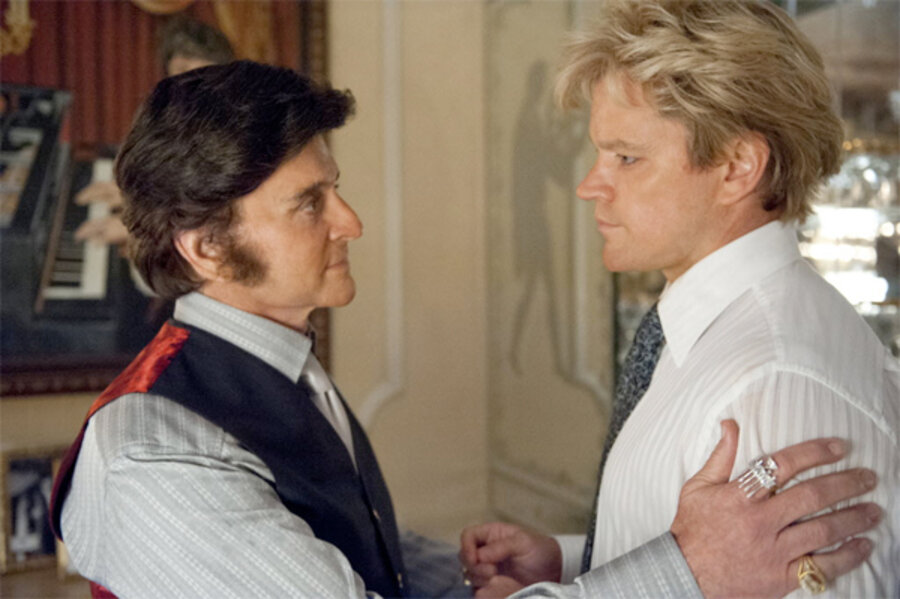'Behind the Candelabra': Before the HBO movie, what did America think of Liberace?
Loading...
He went by one name, but everything else about Liberace came in magnificent multiples: furs and jewels, pianos and candelabras, mansions and pompadours. More than a quarter century after his death from complications of AIDS, Liberace is still an enduring legend of American pop culture. But he's more than that. Bracelet yourself for this revelation: He's one mighty complicated character.
On one hand, he was a conservative Midwesterner who looked askance at the liberties unleashed by the 1960s. And this is a man custom-made for looking askance at things.
At the same time, he was a gay man with lovers galore. But he hid that part of his life from the public through a haze of denials, bamboozling legions of fans who lived in pleasant denial or simply failed to comprehend the message of his grand fabulosity.
"Behind the Candelabra," a new film about Liberace by director Steven Sodenbergh, debuts Sunday on HBO. Starring Michael Douglas and Matt Damon, the movie has spawned a debate over the meaning of this sequined success story.
Darden Asbury Pyron, a history professor at Florida International University in Miami, explored Liberace's life in a deeply thoughtful and scrupulous 2000 biography titled "Liberace: An American Boy."
This week, I asked Pyron to ponder this most unusual entertainer.
Q: I'm sure some people think of Liberace as a joke today. Why do you take him seriously as a performer?
A: All of his contemporaries did. Frank Sinatra, Elvis Presley, all of these guys admired him enormously.
He is the absolute consummate performer, the definite article. He's extremely intelligent, and besides being intelligence, he has a sixth sense about what appeals to people, how far to push things.
He calculated that if people couldn't get things, he'd get them and he'd fulfill them, give them this sense of being in a different world, of getting a brief chance at being rich.
When I was working on the book, I was at my local bank in Miami and talked to a woman about what I was working on. Liberace had been dead for years, but she looked at me with this faraway look and said, "Oh, I always wanted to have a candelabra."
Q: What did he think about his style of performance?
A: He himself talks about how people see art, not just in his performance but art in general, as a way of transcending their own limitations. Art is about introducing you to another kind of world.
Nothing was realistic about him, nothing. He didn't believe in realism or naturalism. His sense about performance was something entirely different. I've never talked to anybody who saw him perform – straight, gay, men, women – who didn't come away just delighted.
Q: Wasn't he corny, though?
A: Someone said that he does the same act all the time and tells the same jokes. When was he going to do new material? His response: When they stop laughing at the old material.
Q: Years ago, I wrote a story about the Village People and was shocked to find that many readers had no idea they were gay icons. This was so obvious to some people, but others were oblivious because they didn't pick up on a kind of cultural language.
Do you think some of Liberace's fans failed to see what seems so clear to us today – that he represents just about every stereotype of a swishy gay man?
A: In contemporary culture, you're gay or you're not, and there are clear divisions. That didn't apply in the '50s, '60s or even in the 1970s. He was able to play with ambiguity and, believe it or not, subtleties of identity.
He was keen to this. After the hippie revolution, he spoke about what we were losing. He didn't put it exactly like this, but he meant losing subtleties of dress and identity.
Q: Did you end up liking the guy?
A: He charms everybody, and he charmed me. He was always a kind of little boy eager to please, who's really smart and can calculate how to charm and please people.
Q: He turned to much younger men as he grew older, and the relationships didn't last. And of course, he had to devote energy to hiding a big part of his life. What do you make of his choices?
A: He has gay critics who focus on the fact that he was not ever an openly gay man, even in his final days. But he was a Midwestern conservative Republican Catholic. He had multiple identities, and that was part of his genius.
Randy Dotinga is a Monitor contributor.





